Best laptops for machine learning in 2025

Machine learning and deep learning tasks demand substantial computing power. Whether you’re training a convolutional neural network on image data or running large language models, having a laptop with a high-performance GPU and CPU along with plenty of RAM and fast storage is crucial. Fortunately, 2025 has brought a new generation of laptops equipped with cutting-edge hardware that bridges the gap between portability and desktop-like performance. In this roundup, we’ll explore eight of the best laptops tailored for machine learning workloads. We’ll cover their key specs, including CPU, GPU (with Total Graphics Power), memory, storage, and display, and discuss how these features make them suitable for ML tasks. We’ve sorted the list from highest to lowest price, so you can easily compare the most premium options with more affordable picks. But before that, let’s debunk the myth of so-called AI laptops, which are advertised with 55 TOPS, while they may not be useful at all for critical ML workloads.
 Survey
SurveyWhy generic AI laptops often fall short for real AI workloads
Generic AI laptops often feature NPUs or “AI accelerators” that are optimized for lightweight inference tasks but fall short in VRAM capacity, tensor throughput, and driver support required by real AI workloads. In contrast, discrete GPUs like the NVIDIA RTX 4060 and above provide the necessary Tensor Cores, AI TOPS performance, and memory bandwidth to accelerate both training and inference of modern machine learning models. Moreover, system-level factors such as CPU performance, system RAM, storage speed, and thermal design play crucial roles in sustaining consistent performance under heavy AI workloads.
Also read: PCIe lane allocation: The silent bottleneck in modern laptops
Many manufacturers market laptops under the “AI laptop” banner primarily because they include an NPU or leverage new-generation x86-based AI engines, but these components typically deliver limited improvements, excelling in tasks like voice transcription or basic image recognition rather than complex model training or large-scale inference. Independent testing has shown that NPUs integrated alongside CPUs cannot match the FP16 and INT8 throughput of NVIDIA’s dedicated GPUs, making them underpowered for higher-tier AI tasks. As a result, relying solely on an NPU-equipped laptop often leads to prolonged runtimes and constrained batch sizes, frustrating developers and researchers aiming to iterate rapidly.
VRAM is a critical resource for AI workloads, as model parameters and intermediate activations are stored in GPU memory during training and inference. GPUs with only 4–6 GB of VRAM, such as mobile variants of lower-tier cards, struggle to accommodate even moderate neural networks without resorting to frequent memory swapping, which drastically reduces performance. Starting with laptops featuring the NVIDIA RTX 4060, which offers 8 GB of VRAM and dedicated Tensor Cores, users gain a baseline platform capable of handling popular models like ResNet50 or BERT with reasonable batch sizes. This hardware threshold ensures more consistent throughput and fewer out-of-memory errors during development.
Also read: Latency vs. bandwidth: Why laptop Wi-Fi cards aren’t all equal
GPU acceleration with dedicated hardware support delivers orders-of-magnitude speedups compared to CPU-only execution, with benchmarks showing that localized model runs on a GPU can outperform a multi-core CPU by tenfold or more. However, thermal design and power delivery in slim laptops often limit sustained GPU clocks, leading to performance throttling under continuous load. Adequate cooling solutions, such as vapor chambers or dual-fan setups, and robust power adapters help maintain higher boost clocks, translating directly to faster training iterations and lower inference latency. In addition, sufficient system RAM (ideally matching or exceeding GPU VRAM by at least 25 percent) and high-speed NVMe storage prevent data transfer bottlenecks and ensure that large datasets can be fed to the GPU without unnecessary delays, while balancing battery life and portability against performance needs rounds out the list of considerations when choosing an AI-capable laptop.
ROG Strix SCAR 16 (2025) G635
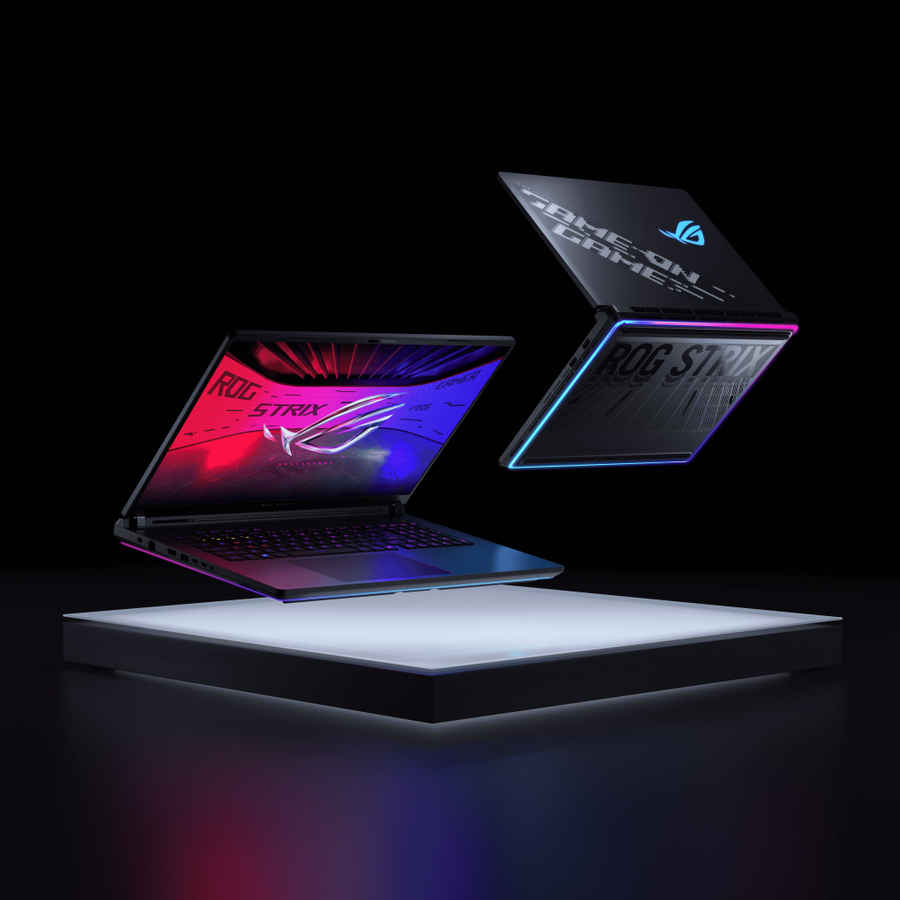
ASUS’s ROG Strix SCAR 16 (2025) G635 is a no-compromise powerhouse. It features an Intel Core Ultra 9 275HX processor (24 cores, up to 5.4 GHz turbo) paired with NVIDIA’s top-tier GeForce RTX 5090 Laptop GPU with 24 GB GDDR7 VRAM. This GPU runs at up to 175 W max TGP for uncompromising graphics and compute performance. The SCAR 16 comes with 32 GB of DDR5 RAM (expandable to 64 GB) and a blazing-fast 2 TB PCIe 4.0 SSD, ensuring smooth handling of enormous datasets and quick load times. Its display is a 16-inch 2560×1600 Mini LED panel (ROG Nebula HDR) with a 16:10 aspect ratio and 240 Hz refresh rate, delivering vibrant colors and sharp details, great for visualizing training results or gaming after hours. Despite the premium hardware, it’s packed in a bold ROG chassis with per-key RGB and robust cooling. The SCAR 16 G635 is priced at ₹379,990, reflecting its position as a flagship model.
Also read: The hidden pixels: How sub-pixel arrangements shape your high-refresh laptop experience
The SCAR 16 pairs Intel’s Core Ultra 9 275HX with NVIDIA’s RTX 5090 running at 175 W TGP and 1824 AI TOPS, currently the highest figure on any laptop GPU. With these extreme specs, the ROG Strix SCAR 16 (2025) is exceptionally well-suited for machine learning tasks. The RTX 5090 GPU’s 24 GB VRAM allows you to train very large neural networks and handle high-resolution data without running out of memory. A 175 W TGP means the GPU can sustain high compute throughput, accelerating frameworks like TensorFlow and PyTorch during model training. The 24-core Intel Ultra 9 CPU provides ample parallel processing for data preprocessing, multi-threaded simulations, or coordinating distributed training. Meanwhile, 32 GB of RAM ensures that even memory-intensive operations (like in-memory data augmentation or large batch sizes) run smoothly. The fast 2 TB SSD offers plenty of space for big datasets and quick read/write speeds for loading data on the fly. In short, the SCAR 16’s top-of-the-line CPU-GPU combo and high-end specs make it a dream laptop for AI researchers and professionals who need maximum performance for deep learning workloads.
Specs at a Glance:
| CPU | GPU | GPU TGP | AI TOPS | RAM | Storage | Display | Price |
|---|---|---|---|---|---|---|---|
| Intel Core Ultra 9 275HX | RTX 5090 24 GB | 175 W | 1824 | 32 GB | 2 TB SSD | 16-inch Mini-LED QHD 240 Hz | ₹379,990 |
ROG Zephyrus G16
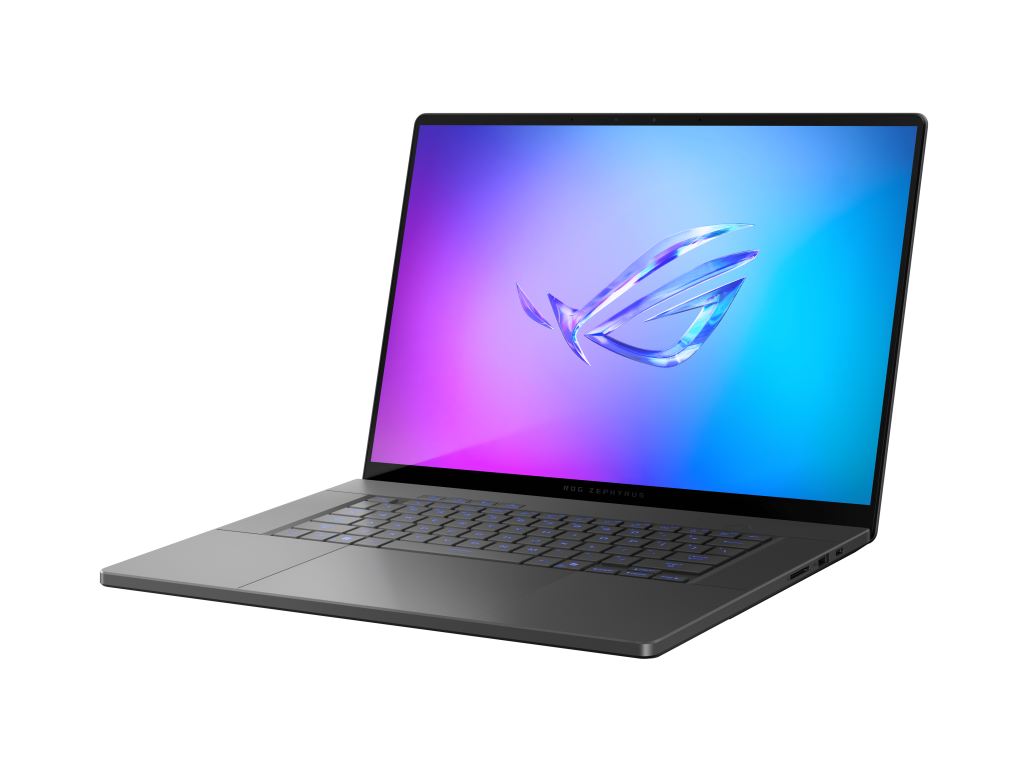
The ASUS ROG Zephyrus G16 (2025) offers high-end specs in a more portable, slim package. It is powered by an Intel Core Ultra 9 285H processor and an NVIDIA GeForce RTX 5080 Laptop GPU. The RTX 5080 comes with 16 GB of VRAM and operates at 120 W TGP, providing excellent graphics compute performance in a thin-and-light chassis. This model includes 32 GB of LPDDR5X memory and a spacious 2 TB PCIe 4.0 SSD, aligning with the needs of heavy multitasking and large dataset storage. The Zephyrus G16 features a 16-inch 2560×1600 240 Hz display – in this configuration, it’s a vibrant OLED panel with a glossy finish, offering rich colors and deep blacks (great for media and accurate visualizations). Despite its power, the laptop maintains a relatively light weight (~1.95 kg) and sleek design, with the distinctive half-perforated lid and understated “Eclipse Gray” finish. Priced at ₹359,990, the Zephyrus G16 targets those who need near-flagship performance in a more travel-friendly form.
Also read: How factory calibration standards differ across laptop brands
What makes the ROG Zephyrus G16 excellent for machine learning is the balance it strikes between power and portability. The RTX 5080 that hits 1334 AI TOPS at up to 120 W GPU and capable of accelerating training for most neural networks, from CNNs to transformers, with its 16 GB VRAM allowing for reasonably large batch sizes and models. It might not hit the absolute peak performance of the SCAR’s 175 W GPU, but 120 W is impressive in a thin laptop and is sufficient for demanding tasks – training times for complex models will still be very fast. The Intel Ultra 9 CPU provides strong multi-core performance for data preprocessing pipelines or running multiple experiments in parallel. With 32 GB RAM, you can load sizeable datasets into memory or run memory-hungry applications like data augmentation tools without bottlenecks. Additionally, the OLED QHD+ screen is a boon for developers – you get a high-resolution workspace for coding and a color-accurate display for visualizing results or editing scientific visuals. The Zephyrus G16 is ideal for machine learning engineers or students who need high performance on the go, making it easier to carry to labs, classrooms, or conferences while still crunching AI tasks efficiently.
Specs at a Glance:
| CPU | GPU | GPU TGP | AI TOPS | RAM | Storage | Display | Price |
|---|---|---|---|---|---|---|---|
| Intel Core Ultra 9 285H | RTX 5080 16 GB | 120 W | 1334 | 32 GB | 2 TB SSD | 16″ OLED QHD 240 Hz | ₹359,990 |
ROG Strix G16 G615
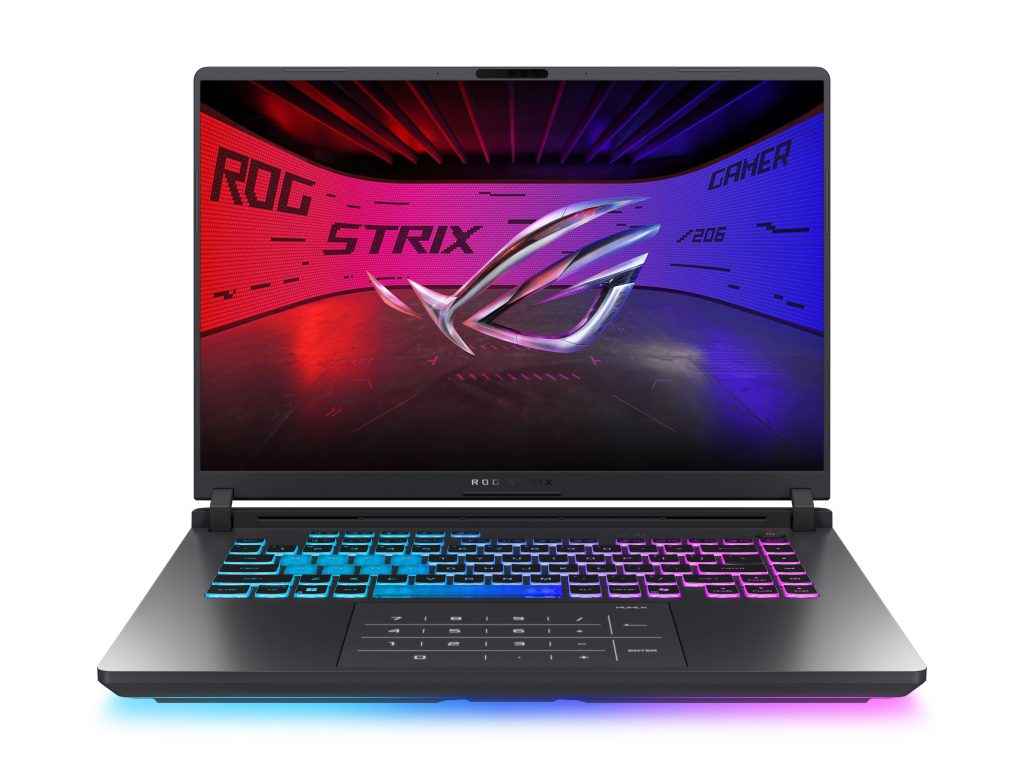
ASUS’s ROG Strix G16 G615LR-S5190WS is a slightly more affordable gaming laptop that still packs a punch for machine learning. It sports an Intel Core Ultra 9 275HX CPU (same 24-core powerhouse as the SCAR 16) paired with an NVIDIA GeForce RTX 5070 Ti Laptop GPU. The RTX 5070 Ti comes with 12 GB of GDDR7 VRAM and runs at 140 W TGP (115 W base + 25 W Dynamic Boost) under ROG Boost settings. In practice, this means you get high-end 50-series GPU performance, just a step below the 5080. This Strix G16 model includes 32 GB DDR5 RAM and a 1 TB PCIe 4.0 SSD – ample for multitasking and storing your active datasets or projects. The display is a 16-inch WQXGA 2560×1600 IPS panel at 240 Hz (a ROG Nebula Display with 500 nits brightness and 100% DCI-P3 coverage, offering vibrant visuals). The design features the Strix series’ edgy gamer aesthetics – complete with per-key RGB lighting and a light bar – but it’s also engineered for performance with a robust cooling system. Priced at ₹259,990, the Strix G16 is a strong mid-high tier option for ML practitioners who want powerful specs without the flagship price tag.
In machine learning tasks, the ROG Strix G16’s hardware holds up very well. The RTX 5070 Ti (140 W) offers 992 AI TOPS, double the 4070’s figure, and is remarkable for this price point. And its 12 GB VRAM is sufficient for training typical models on reasonably large batch sizes. While it won’t match the sheer speed of a 5080 or 4090, it is still a high-performance GPU that will drastically outperform any integrated graphics or older-gen GPUs in ML computations. The 24-core Intel 275HX CPU ensures that CPU-heavy tasks (like data preprocessing pipelines using pandas/Numpy, or compiling large code projects) are handled quickly. Having 32 GB of RAM is advantageous when working with data, you can load large datasets or even run memory-intensive algorithms (like certain clustering or simulation tasks) without issues.
Specs at a Glance:
| CPU | GPU | GPU TGP | AI TOPS | RAM | Storage | Display | Price |
|---|---|---|---|---|---|---|---|
| Intel Core Ultra 9 275HX | RTX 5070 Ti 12 GB | 140 W | 992 | 32 GB | 1 TB SSD | 16″ QHD 240 Hz | ₹259,990 |
MSI Vector GP78HX
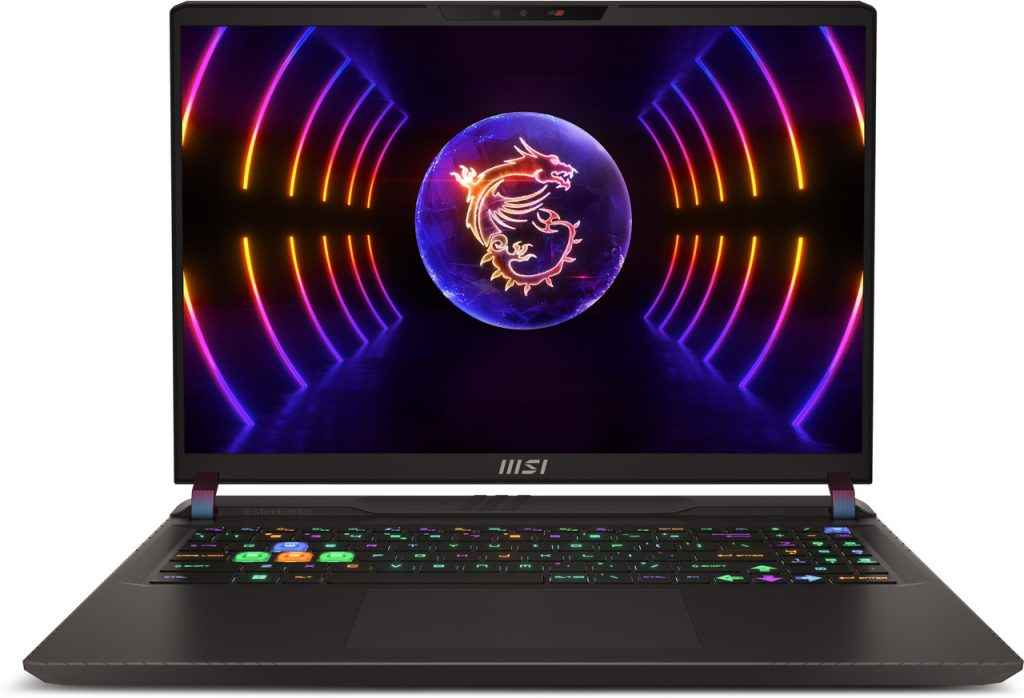
The MSI Vector GP78HX is a 17-inch gaming laptop that doubles as an ML workstation, armed with an Intel Core i9-13980HX (24-core) and an NVIDIA GeForce RTX 4090 Laptop GPU. This top-tier GPU (16 GB GDDR6 VRAM) reaches up to 175 W of graphics power with Dynamic Boost, meaning it can sustain extreme performance during intensive computations. The Vector GP78HX comes with 32 GB DDR5 RAM and a speedy 2 TB NVMe SSD, providing a generous environment for parallel processing and dataset storage. Its large 17.0-inch QHD+ (2560×1600) IPS display at 240 Hz gives you a spacious and smooth canvas – useful for detailed data visualization or simply enjoying games and media. MSI’s cooling system (Cooler Boost 5) and OverBoost technology allow the CPU and GPU to run at high wattages together, which is great for prolonged ML training sessions. Priced at ₹284,999, this laptop is a formidable choice for those who need one of the most powerful GPUs available in a portable form.
For machine learning professionals, the MSI Vector GP78HX’s appeal lies in its raw computing power and large display. The RTX 4090 (175 W) delivers 686 AI TOPS, almost triple what a 4060 offers. With 16 GB of VRAM, it can handle complex models and substantial input sizes (for instance, high-resolution image datasets or longer sequences in NLP tasks) without running out of memory. The 13th-gen Core i9 CPU with 24 cores can manage heavy multi-threaded tasks, such as data preprocessing, hyperparameter tuning (with multiple parallel runs), or even running virtualization/containers for ML services. 32 GB of RAM ensures that large datasets or big matrix operations won’t easily cause memory swaps, maintaining speed during training.
Specs at a Glance:
| CPU | GPU | GPU TGP | AI TOPS | RAM | Storage | Display | Price |
|---|---|---|---|---|---|---|---|
| Intel Core i9-13980HX | RTX 4090 16 GB | 175 W | 686 | 32 GB | 2 TB SSD | 17″ QHD+ 240 Hz | ₹284,999 |
MSI Vector 17 HX
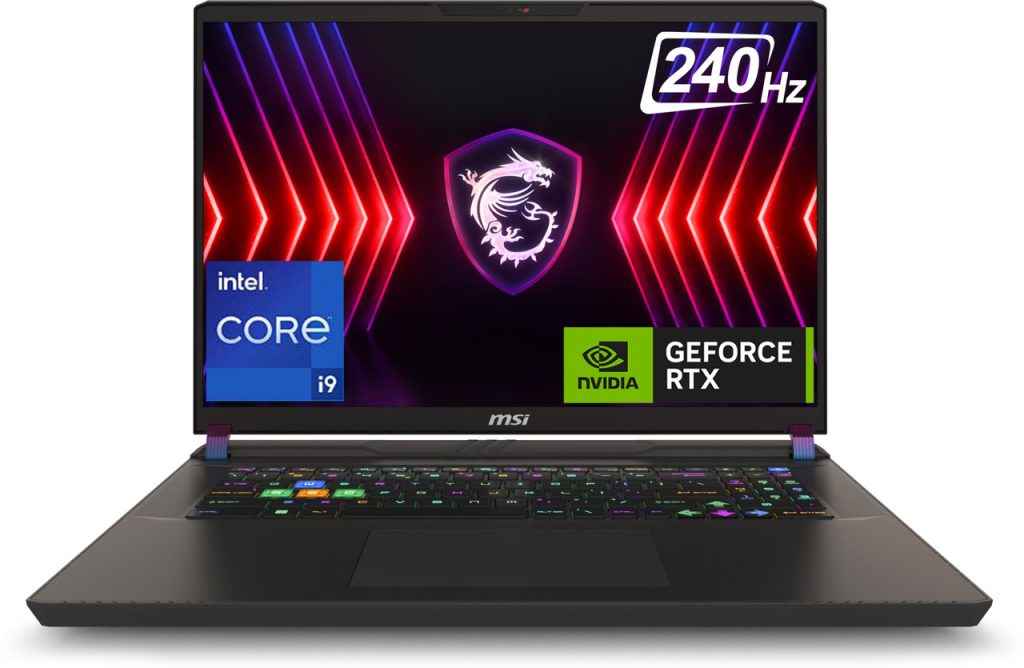
The MSI Vector 17 HX (A14V) brings the latest Intel 14th Gen processor together with a high-end GPU in a 17-inch chassis. It is equipped with an Intel Core i9-14900HX processor (24 cores, 32 threads) and an NVIDIA GeForce RTX 4080 Laptop GPU. The RTX 4080 (12 GB GDDR6 VRAM) in this machine can draw up to 175 W under peak loads, thanks to MSI’s cooling and OverBoost features, so you get very close to RTX 4090-level performance. The laptop includes 32 GB DDR5 RAM and a 2 TB SSD, matching the high-end memory and storage needs of advanced users. The display is a 17.0-inch QHD+ (2560×1600) IPS panel at 240 Hz, identical in size and resolution to the GP78HX, providing ample screen real estate. Design-wise, the Vector 17 HX has a sturdy build with a professional aesthetic (black with subtle green accents), and features like a per-key RGB keyboard. At ₹271,990, it offers slightly more affordability than the 4090 model while still delivering next-gen CPU performance and a top-tier GPU.
The combination of a 14th Gen i9-14900HX and the RTX 4080 makes the Vector 17 HX a formidable machine for ML tasks. The RTX 4080 (175 W max) provides plenty of CUDA cores and tensor cores for accelerating deep learning computations, and you end up getting 542 AI TOPS. With 12 GB of VRAM, it can manage training for complex models (though extremely large models might need to be split or use gradient checkpointing if they exceed this memory). The benefit of the RTX 4080 is that it’s only a notch below the 4090 in performance, but usually generates a bit less heat, which can translate to steadier long-run performance, ideal for multi-hour or multi-day training jobs. Meanwhile, the Core i9-14900HX brings very high single-core speeds and multi-core throughput, which is helpful for any CPU-bound portion of ML workflows (like data loading, augmentation, or running traditional ML algorithms). With this laptop, you can comfortably train neural networks, run parallel experiments, and even do some data analytics or simulation on the side. The large screen and robust port selection make it easy to connect additional monitors or peripherals in a workstation setup.
Specs at a Glance:
| CPU | GPU | GPU TGP | AI TOPS | RAM | Storage | Display | Price |
|---|---|---|---|---|---|---|---|
| Intel Core i9-14900HX | RTX 4080 12 GB | 175 W | 542 | 32 GB | 2 TB SSD | 17″ QHD+ 240 Hz | ₹271,990 |
Lenovo Legion Pro 5
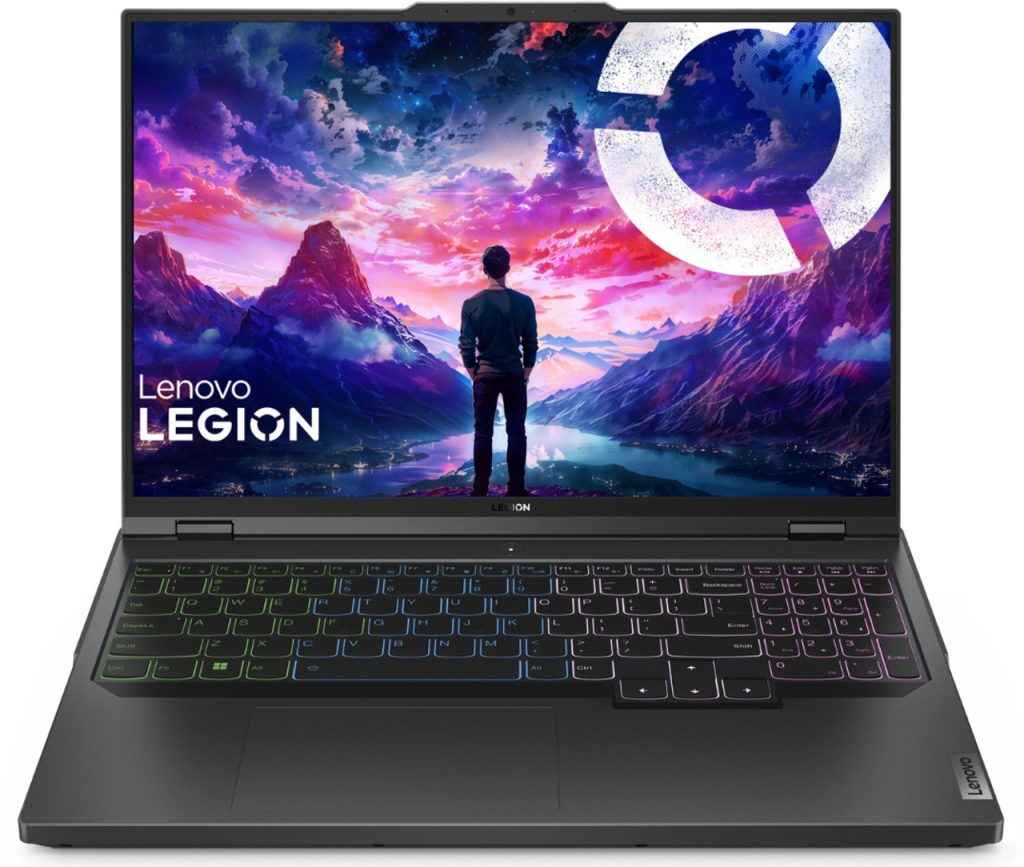
The Lenovo Legion Pro 5 Gen 8 (16ARX8) is a formidable 16-inch laptop that combines AMD’s top mobile CPU with NVIDIA’s mid-high tier GPU. It is powered by an AMD Ryzen 9 7945HX processor – a 16-core, 32-thread beast from AMD’s Dragon Range series, known for strong multithreaded performance. On the GPU side, it features an NVIDIA GeForce RTX 4070 Laptop GPU with 8 GB GDDR6 VRAM. Lenovo configures this RTX 4070 at 140 W TGP (with Dynamic Boost), which is the maximum for an RTX 4070 mobile, ensuring you get the best performance this GPU class can offer. The Legion Pro 5 comes with 32 GB DDR5-5200 RAM and a 1 TB SSD. Its display is a 16-inch WQXGA 2560×1600 IPS panel (16:10) with a 240 Hz refresh rate and high brightness (up to 500 nits), which is great for both gaming and working under various lighting conditions. Legion laptops are known for their excellent thermal design, and this model includes Lenovo’s ColdFront 5.0 cooling system to sustain performance. At ₹200,990, the Legion Pro 5 offers a lot of value, leveraging AMD’s efficient CPU and a strong RTX 4070 for those who need a capable ML development machine on a relatively tighter budget.
In machine learning workloads, the Lenovo Legion Pro 5’s combination of an AMD 7945HX and an RTX 4070 provides a robust platform. The RTX 4070 (140 W) delivers solid performance for training neural networks with 321 AI TOPs. With 8 GB of VRAM, it can handle training of moderately large models, suitable for many use cases like training classification models on ImageNet-sized images, or fine-tuning transformers for NLP with sequence lengths in the hundreds. (It may be slightly challenged by extremely large models or very high resolution data, where 12 GB+ VRAM would shine, but for most practical scenarios, 8 GB is sufficient.)
Specs at a Glance:
| CPU | GPU | GPU TGP | AI TOPS | RAM | Storage | Display | Price |
|---|---|---|---|---|---|---|---|
| Ryzen 9 7945HX | RTX 4070 8 GB | 140 W | 321 | 32 GB | 1 TB SSD | 16″ QHD 240 Hz | ₹200,990 |
HP OMEN 16 (2023)
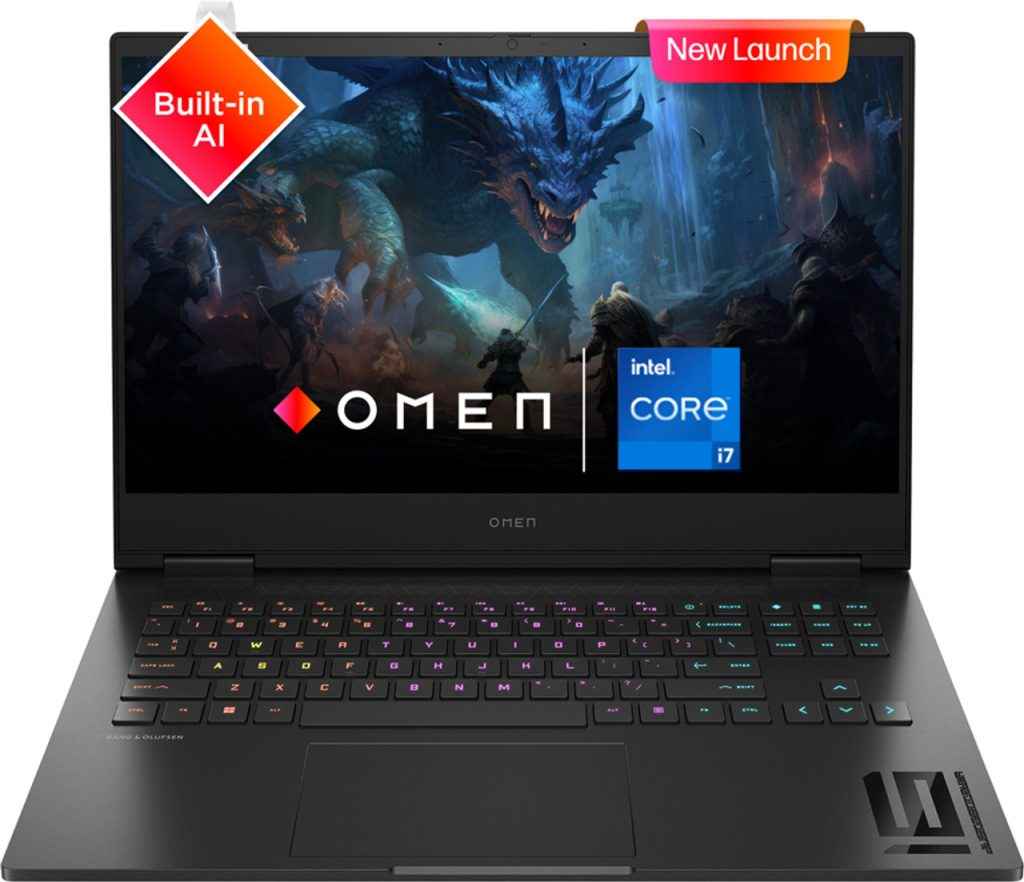
The HP OMEN 16 (model 16-wf0148TX) is a gaming laptop that provides a strong foundation for entry-level to intermediate machine learning tasks at a relatively affordable price. It contains an Intel Core i9-13900HX processor (24 cores, up to 5.4 GHz) and an NVIDIA GeForce RTX 4060 Laptop GPU. The RTX 4060 GPU (8 GB VRAM) in this model is configured to run at up to 145 W TGP, which is noteworthy – it indicates HP is allowing a higher power budget than the standard 115 W base, to maximize the 4060’s performance potential. The system comes with 16 GB DDR5-5600 RAM and a 1 TB PCIe Gen4 SSD. Its display is a 16.1-inch Full HD (1920×1080) IPS panel with a 165 Hz refresh rate. While it’s not QHD, it does cover 100% sRGB and hits 300 nits brightness, providing decent color for development work and gaming. The OMEN 16’s design is sleek yet gamer-oriented, with a Shadow Black chassis and customizable RGB keyboard. At ₹124,990, this laptop is a great value for those who need a powerful CPU and a good modern GPU to get started or progress in machine learning projects without a huge investment.
Despite being one of the lower-priced options in this list, the HP OMEN 16 offers considerable performance for machine learning tasks. The RTX 4060 (up to 145 W) can give you up to 233 AI TOPS, capable of accelerating training and inference for many models quite effectively. With 8 GB of VRAM, you can train neural networks that are of moderate complexity, for example, fine-tuning BERT for text classification, or training ResNet-level image classifiers, as well as run larger pre-trained models for inference or transfer learning. The Core i9-13900HX ensures that you have a top-tier CPU to back up GPU tasks; it will handle data loading, augmentation, and any CPU-bound algorithms (like certain classical ML models or simulations) with ease. The 16 GB of RAM is the minimum we’d recommend for serious ML work, but it is typically enough for handling datasets in the gigabyte range and running multiple applications (you may consider upgrading to 32 GB later, since the OMEN supports it).
Specs at a Glance:
| CPU | GPU | GPU TGP | AI TOPS | RAM | Storage | Display | Price |
|---|---|---|---|---|---|---|---|
| Intel Core i9-13900HX | RTX 4060 8 GB | 145 W | 233 | 16 GB | 1 TB SSD | 16.1″ FHD 165 Hz | ₹124,990 |
GIGABYTE G6X (2024)
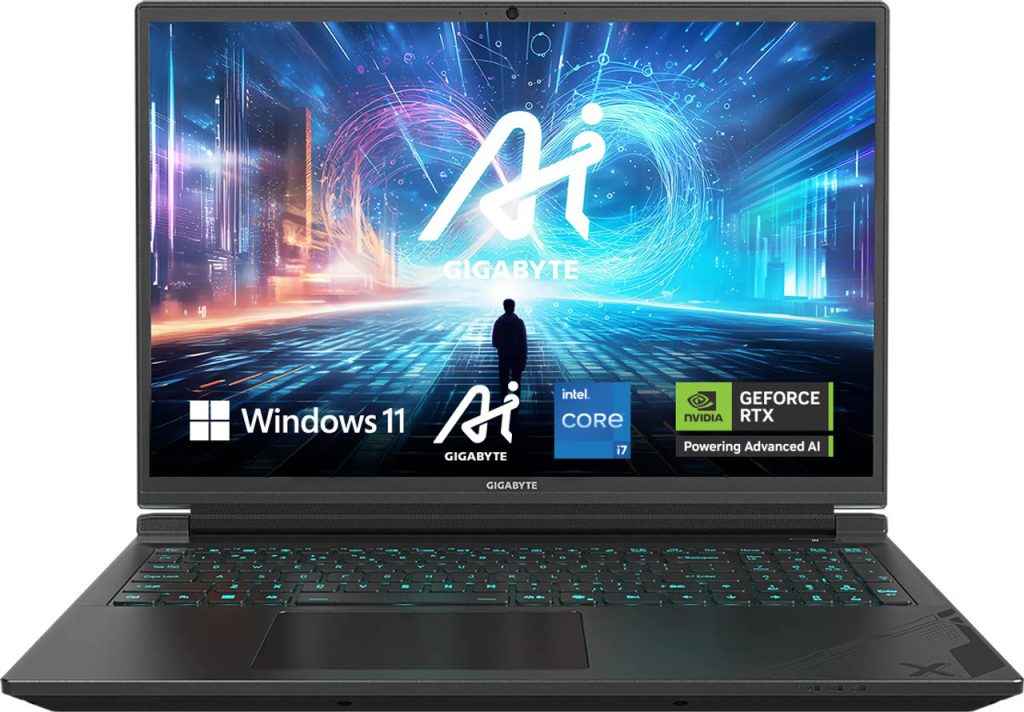
Rounding out our list is the GIGABYTE G6X 9KG, a 2024 model that delivers solid baseline performance for machine learning at the lowest price point here. It features an Intel Core i7-13650HX processor (a 14-core chip with 6 Performance cores and 8 Efficiency cores) and an NVIDIA GeForce RTX 4060 Laptop GPU. In this G6X, the RTX 4060 is tuned to 105 W Maximum Graphics Power, slightly lower than some higher-end models, reflecting a more cooling-conscious design (often termed Max-Q). The GPU still comes with 8 GB VRAM and supports all RTX 40-series features like DLSS 3 and Tensor cores. The laptop includes 16 GB DDR5-4800 memory (configured as 2×8 GB for dual-channel) and a 1 TB SSD, which is a decent starting point; there are additional slots if you wish to upgrade RAM or storage later. The display is a 15.6-inch FHD+ (1920×1200) IPS screen with a 165 Hz refresh rate. While the color gamut is basic (45% NTSC), it’s adequate for coding and everyday use. The G6X has a straightforward design aimed at functionality, with a modest RGB backlit keyboard and a plastic chassis to keep costs down. Priced at ₹84,990, this laptop is an attractive option for those entering the field of machine learning or on a tight budget, yet it still offers the key hardware acceleration features needed for ML tasks.
The RTX 4060 (105 W) GPU will accelerate frameworks like TensorFlow/PyTorch, enabling you to train models much faster than on any CPU. At 105 W, it delivered 233 AI TOPS, it’s a slightly restrained power profile, which means the GPU will boost to a respectable level but also maintain efficiency (useful if you’re running long training sessions; it may generate less heat and noise). The 8 GB VRAM on the RTX 4060 is enough for many entry-level deep learning tasks – for example, training simple convolutional networks on datasets like CIFAR-10 or Cats vs Dogs, working on tabular data models, or fine-tuning smaller transformers for sequences of moderate length. The Intel i7-13650HX CPU, with its mix of performance and efficiency cores, is quite capable for data preprocessing, running training scripts, and even some parallel processing tasks. 16 GB of RAM is a starting point that will handle common tasks (you can train moderately sized models and run data analysis, though you might need to be mindful of very large dataset sizes or multitasking with heavy programs until you upgrade RAM).
Specs at a Glance:
| CPU | GPU | GPU TGP | AI TOPS | RAM | Storage | Display | Price |
|---|---|---|---|---|---|---|---|
| Intel Core i7-13650HX | RTX 4060 8 GB | 105 W | 233 | 16 GB | 1 TB SSD | 15.6″ FHD+ 165 Hz | ₹84,990 |
Which laptop should you buy?
The flagship models (SCAR 16, Zephyrus G16, MSI Vector series) are suited for heavy-duty research and professional work, where saving time is critical and budgets allow for investment in top-notch hardware. Mid-range options (Strix G16, Legion Pro 5) offer excellent performance for most use cases and are often the sweet spot, especially if you’re training models frequently but don’t need the biggest GPU on the market. Finally, the budget options (HP Omen 16, Gigabyte G6X) open the door for newcomers and those with modest requirements, still providing the dedicated GPU and modern CPU needed for genuine machine learning work. Consider your typical workload – if you work with very complex models or extremely large datasets, leaning towards the higher-end will pay off. If your work is more moderate or you’re just starting, one of the mid or lower-tier models will serve you well without overspending. Whichever you choose, each of these laptops can enable you to explore and excel in the exciting field of machine learning in 2025 and beyond.
Sagar Sharma
A software engineer who happens to love testing computers and sometimes they crash. While reviving his crashed system, you can find him reading literature, manga, or watering plants. View Full Profile